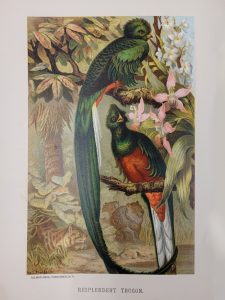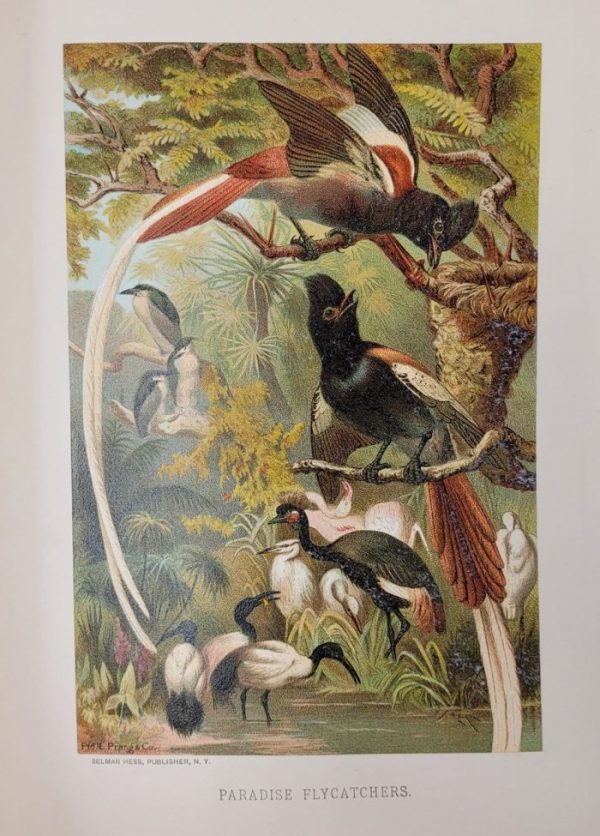Animate Creation: Popular Edition of “A Living World;” A Natural History
by The Rev. J.G. Wood
New York: Selmar Hess
1885
EARTH DAY 2021 – Restore Our Earth
Earth Day has been observed annually in the United States since April 22, 1970 when organizers sought to draw attention to the need for environmental protections after decades of unfettered industrialization and pollution. Millions of Americans were mobilized, participating in rallies, marches and programs driven in large part by students from colleges and universities across the country.[1] Fifty-one years later, Earth Day is now celebrated in almost 200 countries.[2] This year’s theme is Restore Our Earth, emphasizing collective action to prevent the effects of climate change and environmental destruction. Many Earth Day events focus on activism, mobilizing youth and social justice themes.[3]
There are numerous social justice issues related to environmentalism. Developing countries, while most impacted by climate change, are the least able to afford the consequences which are exacerbated by their limited capacity to prevent and respond to the effects of rising seas, deforestation, wildfires, drought, pollution and the like, leaving millions of people vulnerable. In urban areas and developed countries, green spaces improve mental health and well-being while simultaneously protecting watersheds, biodiversity and restoring animal and plant life.[4] The World Health Organization predicts that by the year 2030, approximately 250,000 deaths will result annually from malnutrition, malaria, diarrhea and heat stress due to environmental causes. Gender inequalities are also deepened through losses in health, income and access to resources.[5] As a result, migration will increase and attendant conflicts will rise, resulting in more people competing for fewer available resources.[6] Conservation works to ensure the preservation of the environment, including and animals and plants, as well as people, cultures, heritage, and livelihoods.
vulnerable. In urban areas and developed countries, green spaces improve mental health and well-being while simultaneously protecting watersheds, biodiversity and restoring animal and plant life.[4] The World Health Organization predicts that by the year 2030, approximately 250,000 deaths will result annually from malnutrition, malaria, diarrhea and heat stress due to environmental causes. Gender inequalities are also deepened through losses in health, income and access to resources.[5] As a result, migration will increase and attendant conflicts will rise, resulting in more people competing for fewer available resources.[6] Conservation works to ensure the preservation of the environment, including and animals and plants, as well as people, cultures, heritage, and livelihoods.
Climate change affects everyone in numerous ways. Unsurprisingly, there has been an impetus to view the issue through interdisciplinary frameworks including politics, ecology, ethics, justice, cultural studies, biology, diplomacy, anthropology and various other fields of study.[7] Many scholars and activists view the issue through the lens of interspecies justice and colonialism, like Lia Cheek of the Endangered Species Coalition. She believes the way we relate to nature is an extension of colonialism – taking what we need from the earth without considering, acknowledging or understanding the impacts on others, including plant and animal life which she believes also have rights.[8] Cheek argues present environmental policies, rooted in financial concerns, have led to disastrous results. Consider that three-quarters of the land-based environment and about 66% of the marine environment have been significantly altered by human actions.[9] When The Rev. J.G. Wood published “Animate Creation: Popular Edition of “A Living World;” A Natural History” in 1885, roughly 100 years into the Industrial Revolution, the deleterious effects of industrialization were already becoming known. In response, in 1886, under the administration of President Grover Cleveland, Congress created the Division of Economic Ornithology and Mammalogy, validating Lia Cheek’s assertion about the links between conservation and finances from the advent of the movement.[10] The formation of this government division was preceded by public sentiment in favor of protecting wildlife. In 1883, the American Ornithologists’ Union was created to bring awareness to the need to protect birds and their habitats, which were at risk due to degradation of the environment and over-hunting. In 1895, the first chapter of the Audubon Society was formed with a mission dedicated to the conservation of birds and their environments. By 1905, the National Association of Audubon Societies for the Protection of Wild Birds and Animals was formed.[11]
 In fin de siècle America, bird watching became a popular past time as people became interested in observing birds in their natural habitats. Birding as a past time was aided by instruments such as binoculars and books like the one published by The Rev. J.G. Wood, from which these images come.[12] These colorful and accurately detailed bird illustrations stimulated the popular imagination and introduced many to the idea of conservation and ecology. Wood, a British citizen and parson, was also a prolific and successful natural history writer and lecturer.[13] His drawings vividly illustrated what was at stake if the environment was not protected – spurring activists of his day and beyond to advocate for the environment through rallies, boycotts and legislation.[14] If you would like to take action this Earth Day, you can find events on the Earthday.org website and their Billion Acts of Green Initiative. More locally, you can participate in the Earth Day Cleanup sponsored by DOVE, SAB and the South Orange Community Garden on Saturday, April 24th from 9:30am to 1pm.
In fin de siècle America, bird watching became a popular past time as people became interested in observing birds in their natural habitats. Birding as a past time was aided by instruments such as binoculars and books like the one published by The Rev. J.G. Wood, from which these images come.[12] These colorful and accurately detailed bird illustrations stimulated the popular imagination and introduced many to the idea of conservation and ecology. Wood, a British citizen and parson, was also a prolific and successful natural history writer and lecturer.[13] His drawings vividly illustrated what was at stake if the environment was not protected – spurring activists of his day and beyond to advocate for the environment through rallies, boycotts and legislation.[14] If you would like to take action this Earth Day, you can find events on the Earthday.org website and their Billion Acts of Green Initiative. More locally, you can participate in the Earth Day Cleanup sponsored by DOVE, SAB and the South Orange Community Garden on Saturday, April 24th from 9:30am to 1pm.
The images and materials shown here are but a small part of the vast patrimony available to students, faculty and researchers. For access to this or other objects in our collections, complete a research request form to set up an appointment or contact us at 973-761-9476.
[1] https://www.history.com/this-day-in-history/the-first-earth-day, accessed 4/15/2021.
[2] https://isilanguagesolutions.com/2020/04/22/earth-day/, accessed 4/15/2021.
[3] https://www.earthday.org/earth-day-2021/, accessed 4/15/2021.
[4] https://www.endangered.org/a-conversation-on-endangered-species-and-social-justice/, accessed 4/15/2021.
[5] https://www.international.gc.ca/world-monde/issues_development-enjeux_developpement/environmental_protection-protection_environnement/climate-climatiques.aspx?lang=eng, accessed 4/15/2021.
[6] https://en.unesco.org/courier/2019-3/climate-and-social-justice, accessed 4/15/2021.
[7] https://journals.sagepub.com/doi/full/10.1177/2514848620945310, accessed 4/15/2021.
[8] https://www.endangered.org/a-conversation-on-endangered-species-and-social-justice/, accessed 4/15/2021.
[9] https://www.un.org/sustainabledevelopment/blog/2019/05/nature-decline-unprecedented-report/, accessed 4/15/2021.
[10] https://memory.loc.gov/ammem/amrvhtml/cnchron2.html, accessed 4/20/2021.
[11] https://en.wikipedia.org/wiki/National_Audubon_Society, accessed 4/20/2021.
12 https://www.britannica.com/topic/bird-watching, accessed 4/20/2021.
[13] https://en.wikipedia.org/wiki/John_George_Wood, accessed 4/20/2021.
[14] https://en.wikipedia.org/wiki/National_Audubon_Society, accessed 4/20/2021.
